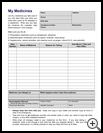
Drug Interactions
________________________________________________________________________
KEY POINTS
- A drug interaction is a change in the way that a medicine works when your child takes it with another medicine. Alcohol, tobacco, vitamins, natural remedies, and certain foods may also interact with your child’s medicines.
- Keep a list of your child’s medicines with you. List all of the prescription medicines, nonprescription medicines, supplements, natural remedies, and vitamins that he takes. Tell all healthcare providers who treat your child about all of the products he is taking.
- Check for drug interactions any time that your child’s medicines change. Try to get all of your child’s prescriptions filled at the same place. Your pharmacist can help make sure that all of your child’s medicines are safe to take together.
________________________________________________________________________
What is a drug interaction?
A drug interaction is a change in the way that a medicine works when your child takes it with another medicine. Alcohol, tobacco, vitamins, natural remedies, and certain foods may also interact with your child’s medicines. Some prescription and nonprescription medicines may have a drug interaction when taken together.
If your child has a drug interaction, he may have an unexpected side effect:
- The drug may not work as well as it should.
- The drug’s effect may be increased.
- Your child may have different side effects.
Higher doses of medicine can sometimes cause more side effects.
What is the cause?
Any time your child takes a new medicine there is a chance it will interact with other medicines your child takes. To avoid problems caused by drug interactions, your child’s healthcare provider and pharmacist need to know about all of the medicines, herbal remedies, vitamins, and other supplements your child takes.
How can I prevent drug interactions?
- Keep medicines in their original containers. Follow the directions that come with your child’s medicine, including information about foods or drinks. Make sure you know how and when your child should take medicine. Make sure that your child does not take more or less than he is supposed to take.
- Many medicines have side effects. A side effect is a symptom or problem that is caused by the medicine. Ask your healthcare provider or pharmacist what side effects your child’s medicines may cause and what you should do if your child has side effects.
- Check for drug interactions any time that your child’s medicines change. Try to get all of your child’s prescriptions filled at the same place. Your pharmacist can help make sure that all of your child’s medicines are safe to take together.
- Keep a list of your child’s medicines with you. List all of the prescription medicines, nonprescription medicines, supplements, natural remedies, and vitamins that he takes. Tell all healthcare providers who treat your child about all of the products he is taking.
If you have any questions, ask your healthcare provider or pharmacist for more information. Be sure to keep all appointments for provider visits or tests.
Last modified: 2016-10-18
Last reviewed: 2016-10-17

